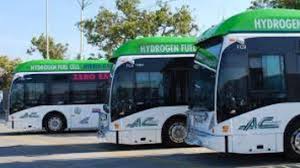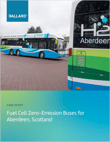Are you thinking about making the transition to zero emission buses?
There are many transit agencies around North America, Europe, and China that are already using hydrogen fuel cell technology in their fleets. We had the opportunity to sit down with Chris Peeples of one such agency, AC Transit, to learn about his first-hand experience with hydrogen powered buses.

Chris Peeples is on the board of directors at AC Transit in Alameda-Contra Costa Transit District (AC Transit) in California. He is a long time advocate for public transit and is a strong supporter of AC Transit’s zero emission hydrogen powered bus initiatives. AC Transit currently operates the largest fuel cell bus fleet in the world,
In this interview, Chris provided his insights on successes and challenges, as well as his outlook on the future of fuel cell electric buses in our communities.
Q & A with Chris Peeples: Transitioning to Hydrogen Powered Buses
When was AC Transit’s fuel cell bus program initially implemented?
The first time we encountered fuel cell technology was at APTA (American Public Transportation Association) in 1999, where there was a Ballard P3. Later that year, we were hosting the California Transit Association, so we talked Ballard into loaning us the bus for that week.
Ballard sent it across the country, we kept it for a week, and filled it up with sandbags, and drove it around some of our most challenging routes, like one with a 21% grade for half a block. And the bus performed quite well!
Before this, we had a zero emission demonstration program, using some battery powered buses. Unfortunately, it turned out these buses were great for parades, but didn’t work well otherwise in terms of range and operability.
Also, in the late 1990s, the California Air Resources Board was trying to convince all transit agencies to make the switch to CNG. However, at the time the CNG buses didn’t work very well, particularly under heavy loads and on hills.
We came to the conclusion that the only viable zero emission technology was hydrogen fuel cells. Our initial fuel cell bus came from Sunline Transit, and we drove it for a few years. This initial experiment went well, and gave us encouragement that fuel cell buses could work long term.
We got some grant funding in 2005, which got us three new fuel cell buses, helping us to expand our fleet.
And by 2009, even though we were the world’s biggest proponent of fuel cell technology, we weren’t ready for widescale commercial deployment. However, since then, our experience with our newer buses has convinced us that the technology issues have been worked out and that fuel cell technology is now ready for prime time.
What were the challenges of implementing the program?
It’s important for anyone considering adopting this technology to talk to people who have been using it for awhile, like AC Transit and Sunline Transit in the US. Talking to current users will help you learn about some of the pitfalls.
For example, it takes lots of PR work to inform and convince local jurisdictions that hydrogen is safe. When another local transit agency did their fuel cell bus experiment, the local fire marshal found out about it in the newspaper, and immediately red tagged the station. The experiment ended up being shut down for three months!
At AC Transit, we learned from that situation, so during our own station planning phase, we brought the fire marshals into planning process very early on in the planning process.
But actually, hydrogen is a whole lot safer than gasoline, and it’s much safer than your local Shell station!
Anyone who works in disaster preparedness doesn’t look at the positive. Their main concern is if everything screws up, how bad is it going to be? So it’s important to have rational conversations with these people around safety.
Convince them that if everything screws up, it’s not going to be any worse than the situations they are already dealing with.
Now the issue is getting enough demand for hydrogen and fuel cells in other communities, so production can increase and costs can go down.
The good things is, the costs have already come down, for example, our first buses were $3.2 million each, our current buses were $2.5 million each, the Ballard powered New Flyers we are getting in 2018 will be $1.2 million each. The current 142 bus European order is coming in at $700,000 each.
Who was your inspiration for implementing this program in your community?
I was an early enthusiast for fuel cell technology, and have seen the technology evolve to what it is right now. I saw my first fuel cell in 1960, and my uncle Robert D. Foley was one of developers for the PEM fuel cell in the Gemini 5 at General Electric in Schenectady, New York.
I used to spend my summers up in Schenectady. Once a year they would open up the labs so you could see where they worked.
In his lab, there was this thing with a couple of rubber bags the size of a soccer ball, that fed into something that was driving a propeller. That was one of the very early fuel cells that was developed for Gemini, but in fact, the technology goes back to the 1880s!
How has your local community reacted to the fuel cell buses?
The buses are operationally good, and perform very well!
The community loves them because they are zero emission, and also because they are very comfortable, and provide a smooth ride for passengers. In addition, operators have reported being very favorable towards the technology.
What is your advice for agencies starting a zero emission program today?
Transit agencies starting out today should look at two things: funding sources and route characteristics. As you know, all major European cities are going diesel-free in the next 10 years, and it is likely that North America will follow. So agencies need to choose the best zero emission solution for their needs and routes.
In addition, people need to understand that fuel cell technology is mature, but supply chains and fuelling chains are not. At AC Transit, we source 65 kg of hydrogen a day from from solar power and another 65 kg a day from biogas. The rest of it gets brought up in a diesel truck from LA. That’s pretty silly!
So you need to look for hydrogen sources around you. There are weird sources of hydrogen all over the place, for example, food industries, refining industries produce vast amounts of it.
Also, many people don’t know that pulp mills, and the production of pulp generates a ton of hydrogen. So, moving forward, there is a lot of potential to discover and produce new and varied sources of hydrogen all around us.
What does the future of fuel cell electric buses look like?
The future looks pretty bright! More and more people are getting on board with the technology.
Our new maintenance manager, Sal Llamas, was very skeptical of hydrogen technology at first, but now is as big of a supporter as I am!
AC Transit has around 400 mechanics. Sal has now set up a training program so that every one of them will get basic training for fuel cell safety, fueling, and maintenance. In addition, another small group will get basic training on diagnostics. This second group will start out small at first, but we plan on growing it in the future.
Take a look at what’s happening with the JIVE project that is deploying 144 fuel cell buses in 10 European regions and cities! They are trying to accelerate commercialization of fuel cells and hydrogen technologies, as a result they got the price of a bus down to €650,000.
That’s getting in the ballpark of the price of a diesel hybrid. Advancements like this are moving the technology to a day-to-day offering for zero-emission public transport.
My personal goal is to have 600 fuel cell buses at AC Transit. I also want to move the conversation away from hydrogen aficionados and toward the general transit industry.We want to expose the fuel cell buses to more people, and educate them that there is a technology that does not have the range limitations or the long fueling times as some of the others.
For example, I can refuel one of my fuel cell buses in 6 minutes! So we need to raise awareness in the general public that this is a viable technology.
Takeaways
Throughout his years in the transit industry, Chris Peeples has seen hydrogen technology evolve considerably. The time is now ripe for fuel cell buses to be deployed on a larger scale.
As more transit authorities adopt this technology, the cost will decrease and the infrastructure needed to support growth will develop. Chris envisions large-scale fuel cell bus deployment for AC transit and provides inspiration for other transit leaders who are looking to implement zero-emission solutions in their fleets.
Are you considering deploying fuel cell electric buses in your transit fleet? Let us know your thoughts in the comments below.
For more information on the performance of hydrogen powered buses, read our latest case study from Aberdeen, Scotland.




